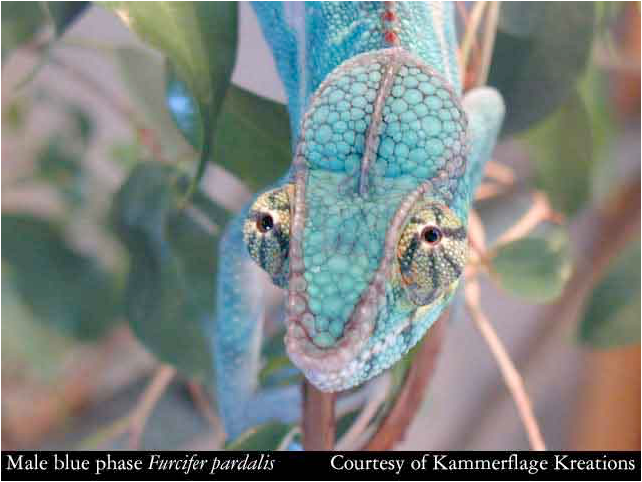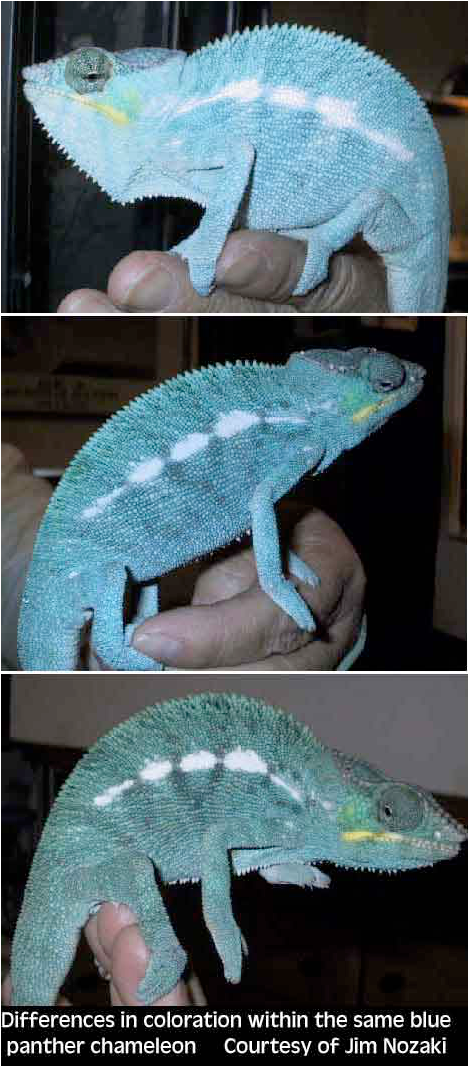



Furcifer pardalis - I’ve Got the Blues!
By Bill Strand
Citation:
Strand, B. (2002). Furcifer pardalis - I’ve Got the Blues!. Chameleons! Online E-Zine, March 2002. (http://www.chameleonnews.com/02MarStrandBlues.html)
Introduction by the CHAMELEONS! staff:
Humans have a long history of keeping animals. And since the first farmer decided he liked chickens with longer tails we, as a species, have selectively kept and bred those animals that are most pleasing to us. The blue Panther Chameleon is the chameleon that best represents this tendency. Breeders have selectively bred this species to bring out a particular color that we find fascinating. Since the whole purpose of the selective breeding is to make an animal more appreciated by human beings it is no surprise that the blue panther is so popular. In the following article Bill Strand provides an overview of the blue panther and the details surrounding finding one for yourself.
Furcifer pardalis - I’ve Got the Blues!
Introduction
The blue color phase of the Panther Chameleon (Furcifer pardalis) is one of the most popular and sought after of all chameleons. Until recently, panther chameleons sporting the rich blues so desired have been difficult to find. Lack of information has created a great deal of frustration. This article will attempt to clear up some common misconceptions and provide the information needed to make an educated search for a truly blue Panther Chameleon.
Where Does a “Blue Panther” Come From?
The Blue Panther originates from an island off the Northwest coast of Madagascar called Nosy Be. In Malagasy, Nosy is the word for “island” and Be means “big”. Olaf Pronk has generously offered the following WAV file of a native Malagasy speaking the name:
What Does a Blue Panther Look Like?
Male Panthers direct from Nosy Be are, typically, bluish-green with varying amounts of red flecks scattered around the body. Many have a red star pattern radiating from their eye turrets and across their cheeks.
The Nosy Be females' coloration can be a mixture of orange, coral, pink, brown, and whites. The gravid coloration of a female F. pardalis will shift to a deep orange with black vertical banding. Many Nosy Be females will also have blue flecks throughout their body, blue or purple cheeks, and a light blue dorsal crest. These indicators are not enough to identify females from other morphs as the female F. pardalis from Ambanja also may have these colors.
Over the years, breeders collected wild caught Blue Panthers as they were imported and selectively bred to encourage purer and purer blues. The scarcity of males that were considered blue and not aqua or blue-green made this effort tricky. To cause even more difficulty, the color passed on by wild females is a huge variable that takes, at least, a generation or two to determine. The collectors of today have the huge advantage, as there are a number of established blue lines that consistently produce blue offspring.
The Blue Panther, as found in the captive bred market today, has many variations. Each animal shows a different deepness of blue and varying amounts of red and yellow. It is common to find blue panthers with yellow lips, red on the eye turrets, and/or red flecks scattered throughout the body.
When hatched, the baby Blue Panther will appear as any other Panther Chameleon. It will be dark brown with a white horizontal stripe down the middle of its flank. Within two to three months blue hues will start showing up on the flank, dorsal crest, and cheeks. Both males and females may show this blue coloration. Some clutches are easy to tell sexes apart as the males will tend towards a gray overall color while the females will stay a light brown. This is not a sure way to sex panthers as some clutches will be born with both male and female staying the light brown. As males mature a subtle hemipenal bulge forms where the tail meets the underside of the body. This is a way to determine a male, but the absence of a bulge is not a positive test for a female as the specimen might be a male that has not yet developed or is genetically more streamlined.
As the male Blue Panther approaches it's six-month birthday it should already be showing an overall light blue blush of coloration starting to come through. It is normally between six and 12 months that adult coloration will be apparent. This time frame is heavily dependant upon the birth size and the quality of the husbandry conditions under which the panther is raised. Items that may slow growth include nutritionally deficient food, inadequate amounts of food, and cool temperatures.
How to Shop For a Blue
If you have decided on a Blue Panther for a pet then you have probably done so because of the color and are searching for that elusive blue animal. This section will focus on helping you stack the odds in your favor for getting the color of animal you desire. Although many of the same steps apply, getting started in a Blue Panther breeding project is much more involved. The task of gathering animals for a breeding project is addressed in the “From the Breeders” column in this issue.
The assumption is that if you have decided to get a Blue Panther for a pet you will get a male. Females each have their own swash of subtle colors, but it is the male that will show the colors the blue panthers are famous for.
Your options for obtaining a blue panther are wild caught and captive born. Looking for a wild caught blue colored Panther Chameleon will be an exercise in patience and tenacity. If you are lucky enough to have a close working relationship with an importer, then you can sift through all the panther shipments that come in to look for the color you want. This is, essentially, looking for the needle in the haystack and has the potential for taking a very long time. The average person does not have this relationship with the importer and must rely on retail outlets and private breeders.
Reasons For Captive Born
A Captive Born (C.B.) chameleon is, simply, one that was born in captivity. Technically, a panther, which hatches from an egg, should be called Captive Hatched (C.H.), but the term “Captive Born” (C.B.) has come to cover both live birth and hatched chameleons. The C.B. or C.H. designation usually means the panthers were from eggs laid by a female that was imported gravid.
It is no news to the seasoned chameleon keeper that captive born chameleons are the best bet for life with people. A captive born chameleon is acclimated to living in a cage and seeing humans around it. The parasite levels will be drastically reduced (indeed, if any are detectable). If cared for properly, a chameleon raised in captivity will not have endured hunger, adverse weather conditions, other animals trying to eat it, or battle scars from day to day life in the outside world.
If you are buying a captive born animal then, most likely, you are buying a baby. You will not know what the baby's color will be until it grows up many months from the purchase date. Beware. It is common practice for reptile vendors to advertise 'Nosy Be Blues' and send you an animal that has its origin in Nosy Be. They have no problem allowing you to think you are getting a blue animal just to make the sale. You, most probably, will end up with the standard blue-green animal. The only time you should buy from an unknown lineage is if you are buying an adult and can see what you are getting! If you are shopping for color do not even consider buying a panther not yet fully colored from a source that does not know the father of the clutch. Which is why, for babies or juveniles, you must go beyond Captive Born to Captive Bred and Born.
Reasons For Captive Bred
A general reason to buy captive bred (C.B.B. for Captive Bred and Born) is that the mother of the babies you are buying was, if you are purchasing from a reputable breeder, pampered during pregnancy. The baby you are purchasing benefited from a mother that had enough food to go around. The reverse is true, though. If the breeder did not take good care of the mother and did not pay attention to diet then the babies may suffer for it. Before selecting a source for your new chameleon familiarize yourself with the breeders making chameleons available to you. There are many out there and they all have reputations. Asking around will help you decide whom you want to trust.
A specific reason to buy captive bred in the case of juvenile blue panthers is that you have information on the lineage of your potential chameleon. You are buying for color. Neither you nor the seller really can have control over the color of the juvenile you are purchasing. But by checking out the lineage of your potential purchase you increase the chance the baby will turn blue as an adult. A good number of bloodlines from reputable breeders are available that consistently produce blue animals. A reputable breeder will be able to provide pictures of the father of the clutch and tell you the lineage of the female. The longer her bloodline has been bred for blue the better the chance her offspring will continue the tradition. Some breeders are also even able to produce pictures of the mother's father and a picture of an adult brother. A reputable breeder will have pictures, at least of the father, readily available and will email them without hesitation if the pictures are not already posted on a website. If the breeder you are talking to hesitates at all to provide a picture or does not have a picture then you should consider taking your business elsewhere. People that are breeders of blue panthers understand that their customers are as picky as they were when they were putting together their breeding stock. They will eagerly provide you evidence of their hard work! Alas, it is too easy for an unscrupulous dealer to doctor a photo to look blue and/or show you photos of nice Blues and send you some hatchlings from eggs that came from an imported female. The only way to avoid being taken into this trap is to ask around for the reputable breeders. The internet has brought together much of the chameleon world and there are ample resources for information exchange. A chameleon listserve is probably the easiest tool for this purpose. A suitable listserve may be found with the search word “chameleon” on web sites such as www.yahoogroups.com and www.topica.com.
What NOT to Expect From Your Blue Panther
While a captive born chameleon has many powerful advantages over a wild caught chameleon, the keeper must still acknowledge the limitations of captive born chameleons. Being brought up in captivity does not change that they are chameleons. Chameleons, in general, are shy and even a chameleon raised in captivity will retain a level of shyness. Anecdotal stories floating around of chameleons that give the appearance of enjoying human interaction are common, but would be exceptions to the pretty reliable rule that chameleons like to be left alone. The human interaction tolerance level is different for each individual chameleon and it must be respected. Though you may get lucky and have a sweet tempered panther, do not expect your chameleon to enjoy being held.
What You CAN Expect From Your Blue Panther
Panther Chameleons are relatively intelligent when compared to other chameleon species. They easily recognize different people and even wild caught panthers will quickly learn if a person coming by means food or not. If the same people take care of the chameleon, a Panther Chameleon will often learn their faces. The caretakers will be accepted more than strangers.
You will learn what his comfort level is. Respect it and do not force him into situations where he is stressed. He will show discomfort by trying to run away and hide. It is important that the chameleon always have an area in his cage where he can hide. An appropriate hiding spot is a dense plant or a perching stick that is shielded from view by hanging vines. A chameleon hiding place is one that provides visual isolation. After a while, there is a good chance that a panther will allow you to approach without exercising his hiding rights. Panthers are, by nature, chameleons that enjoy being out in the open. Once he feels comfortable with his living situation this nature will show itself.
The Blue of the Blue Panther
Chameleons change color. Even though your Panther is bred for blue he will still have a range of colors that may span dark, dirty, blue-green to light aqua to speechless blue. This all depends on his mood, health, and environmental conditions. It also depends on his age. Through out his life his color and intensity will change.
Do diligent research and stack the odds in your favor for the color you want. Once that is done you must create the best environment possible. There is a wealth of information available for the care of Panther Chameleons. Many books and websites address this topic. Care is beyond the scope of this article, but bringing out the best blue will be addressed. A Blue Panther kept under artificial lights may not show his colors. The simplest way to bring out his best colors is to place him in natural sunlight on a warm day in a high place. It is when he feels like he is king of his domain that you will see the most pleasing colors.
Regardless of his color, a “Blue” is a Panther Chameleon. Panthers may be considered one of the top chameleons for their confidence, intelligence, size, and color. They are one of the few chameleons that will establish a basic relationship with their keepers. Whether he is showing his dress blues or is having a casual day you have a creature of beauty and a spectacular piece of nature!










Bill Strand

Bill Strand currently works in the area of exotic animal breeding and continues to refine husbandry techniques with a broad range of chameleon species. A special interest of his is the creation of captive environments. He was the Assistant Editor and Webmaster of this Chameleons! E-Zine from March 2002-March 2004.









Join Our Facebook Page for Updates on New Issues:
© 2002-2014 Chameleonnews.com All rights reserved.
Reproduction in whole or part expressly forbidden without permission from the publisher. For permission, please contact the editor at editor@chameleonnews.com
